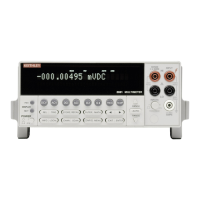IEEE-488 Reference
4-130
Defaults Power-up Saved power-on setup
*RST ON (all functions)
:SYSTem:PRESet ON (all functions)
Query :AUTO? Query autorange (on or off)
Short-form formats: :curr:ac:rang:auto?
:curr[:dc]:rang:auto?
:volt:ac:rang:auto?
:volt[:dc]:rang:auto?
:res:rang:auto?
:fres:rang:auto?
Response message: 1 (on) or 0 (off)
Description These commands are used to control autoranging. With autoranging enabled, the instrument will
automatically go to the most sensitive range to perform the measurement. Typically, autorange
is used for most measurements except when maximum speed is required. With autorange dis-
abled, the instrument does not perform the time consuming search for the correct range. The re-
sult is a faster reading rate.
The ONCE parameter is analogous to a momentary toggle switch. When :RANGe:AUTO
ONCE is sent, autorange will enable and the most sensitive range will be selected for the input
signal. Autorange will then disable, but the selected measurement range will be retained. Note
that the instrument must currently be on the specified function in order for ONCE to be effective.
Using ONCE while on any other function will result in an error.
The autorange command (:RANGe:AUTO) is coupled to the command that manually selects the
measurement range (:RANGe <n>). When autorange is enabled, the parameter value for
:RANGe <n> changes to the automatically selected range value. Thus, when autorange is dis-
abled, the instrument will remain at the automatically selected range. When a valid :RANGe <n>
command is sent, autoranging will disable.
When using autorange, upper and lower range limits can be established to keep the instrument
from autoranging to ranges that are not going to be used. (see :AUTO: ULIMit and :AU-
TO:LLIMit commands).
Programming example 10 OUTPUT 716; “:curr:ac:rang:auto on; auto?”
20 ENTER 716; A$
30 PRINT A$
40 END
Line 10 Enables auto range and then queries auto range.
Line 20 Addresses the Model 2001 to talk.
Line 30 Displays autorange status (1; on).

